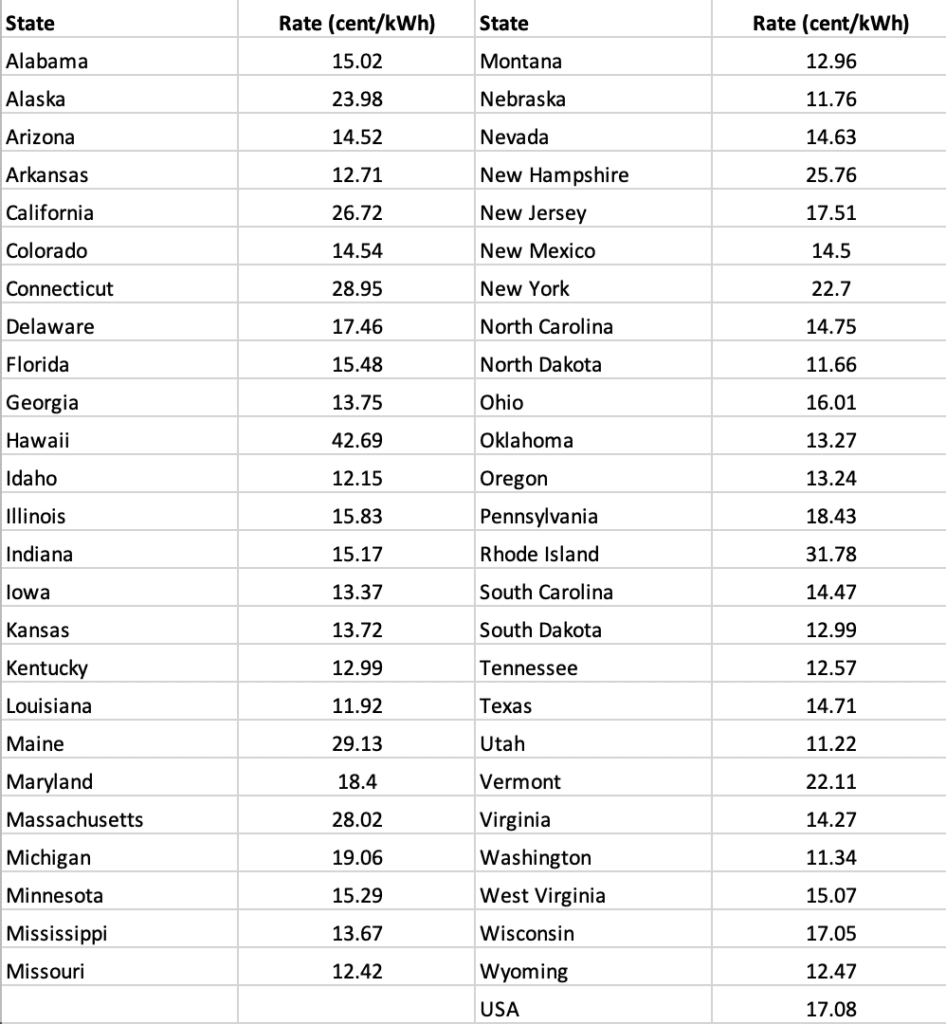Average Electricity Price Rose As Of 2024
[Update 1/21/2024: we updated all electricity prices using the latest rolling 12 month average data for different states]
Here in the U.S. electricity prices rose in 2022 and 2023 due to inflation. Since then, inflation has moderated so we expect less of a price increase in 2024. US grid electricity depends on fossil fuels which includes oil and natural gas, as well as a growing share of renewables and nuclear power.

As prices of oil and natural gas rise and fall, so do electricity rates. Even though the U.S. is a net oil producer and extracts a lot of its own fossil fuels, its part of the free market. As such, energy commodities will flow to where prices are and impact everyone.
We analyzed data from the EPA data store, specifically residential electricity prices. Commercial vs residential electricity rates are quite different. Here is a table of estimated electricity prices for each state. Please check out our city-specific electricity rates for much higher geographic resolution.
Estimated Electricity Prices In Cents/kWh For Each State

Don’t forget that these are only estimates. Every house is supplied by a specific utility company or energy supplier, each of which is purchasing, and delivering electricity at a specific cost. Therefore, electricity rates, especially in deregulated markets, change constantly. In fact, switching electricity companies is a household strategy in deregulated markets to reduce costs.
An average American home that uses 880 kWh per month, which includes running fridges, ovens, humidifiers, air conditioners.
For an average American home, the cost of energizing a house every month therefore has gone up from $123 to $132. You can read more on our website about average house hold electricity use.
We reproduce the image above in tabular form that you can copy and paste and use yourself below.
| State | Rate (cents/kWh) | State | Rate (cents/kWh) |
| Alabama | 15.02 | Montana | 12.96 |
| Alaska | 23.98 | Nebraska | 11.76 |
| Arizona | 14.52 | Nevada | 14.63 |
| Arkansas | 12.71 | New Hampshire | 25.76 |
| California | 26.72 | New Jersey | 17.51 |
| Colorado | 14.54 | New Mexico | 14.5 |
| Connecticut | 28.95 | New York | 22.7 |
| Delaware | 17.46 | North Carolina | 14.75 |
| Florida | 15.48 | North Dakota | 11.66 |
| Georgia | 13.75 | Ohio | 16.01 |
| Hawaii | 42.69 | Oklahoma | 13.27 |
| Idaho | 12.15 | Oregon | 13.24 |
| Illinois | 15.83 | Pennsylvania | 18.43 |
| Indiana | 15.17 | Rhode Island | 31.78 |
| Iowa | 13.37 | South Carolina | 14.47 |
| Kansas | 13.72 | South Dakota | 12.99 |
| Kentucky | 12.99 | Tennessee | 12.57 |
| Louisiana | 11.92 | Texas | 14.71 |
| Maine | 29.13 | Utah | 11.22 |
| Maryland | 18.4 | Vermont | 22.11 |
| Massachusetts | 28.02 | Virginia | 14.27 |
| Michigan | 19.06 | Washington | 11.34 |
| Minnesota | 15.29 | West Virginia | 15.07 |
| Mississippi | 13.67 | Wisconsin | 17.05 |
| Missouri | 12.42 | Wyoming | 12.47 |
| USA | 17.08 |
Average Electricity Prices Around The World In $/Kwh
[Note: this section is out of date] Remarkably, the average electricity price in America remains far below that of many other countries. It doesn’t matter where you go in the world, people love to moan about the cost of electricity.
This begs the question, where is electricity actually expensive and where is it cheap. Or better yet, is your electricity cheap or expensive?
Average Electricity Prices From 17 Countries Compared
[Note: this section is out of date] To answer this question in an older analysis we collected average electricity prices from 17 countries around the world, and converted them to $/kWh (US).
All the data is based on average prices and exchange rates for 2011, and we’ve graphed them in US cents/kWh to keep it tidy.

Denmark, Germany and Spain have expensive electricity. In fact in straight dollar terms Denmark is trumped only by small island countries dependent on imported diesel for power.
Canadian electricity is cheap at 10 US cents per kilowatt hour, which is reflected in their high average electricity usage. Is that due to colder climates and therefore more use of electricity based heating?
We don’t know. US electricity prices at 0.12 $/kWh (now 0.15 $/kWh) are also quite cheap internationally. In India and China they are very cheap.
Electricity prices are on the move in many places, South Africa, Australia and Nigeria come to mind. And secondly, exchange rates aren’t the best measure of price due to purchasing power parity.
We reproduce the chart above with 2023 data and in tabular form here. We chose slightly different countries for their population representation.
The world has changed a lot and electricity rates are much higher due to the energy crises of 2022 when Russia invaded Ukraine and upended natural gas supplies. Some countries have remained insulated, for example, US, Canada, Australia.
| Country | Electricity rates (2023) |
| Germany | $0.46/kWh |
| UK | $0.42/kWh |
| Spain | $0.37/kWh |
| Netherlands | $0.34/kWh |
| Ireland | $0.33/kWh |
| Sweden | $0.29/kWh |
| Australia | $0.21/kWh |
| France | $0.19/kWh |
| New Zealand | $0.19/kWh |
| Philippines | $0.18/kWh |
| South Africa | $0.16/kWh |
| Hong Kong | $0.16/kWh |
| Japan | $0.15/kWh |
| US | $0.17/kWh |
| China | $0.14/kWh |
| Canada | $0.11/kWh |
| Italy | $0.10/kWh |
| Indonesia | $0.09/kWh |
| India | $0.07/kWh |
| Russia | $0.06/kWh |
| Malaysia | $0.05/kWh |
Adjusting By Purchasing Power Changes Relative Price Of Electricity
Our initial comparison of electricity prices didn’t account for the fact that price levels vary a lot between countries. For example a US dollar will go a lot further buying goods and services in relatively cheap India than it will in relatively expensive Australia.
If we look at the same average electricity prices for 2011 but this time adjust them to US dollars using purchasing power parity the picture look slightly different.

Once you adjust for the different price levels between countries Canadians have the cheapest electricity and Germans the most expensive.
Places like Nigeria and India have jumped up the list due to their lower price levels, while countries including Denmark, Australia and Japan have fallen because they are relatively expensive places to live.
In general accounting for purchasing power lessened the difference between countries, but significant differences remain.
Discussion Of Energy Changes
In these prices, the costs for transport and delivery are included. The infrastructure used to move electricity around is owned by your local utility. The supply of electricity comes from other entities. In fact, in deregulated states it’s possible to find alternative electricity providers.
Since then, there’s been big changes.
Inflation is key among them. And part of the source of inflation is energy shortages caused by conflict. What is fairly interesting is that the costs of electricity vary widely from 9 cents per kWh to 44 cents.
Accordingly the price differences will be one factor that has an impact on which states use the most electricity for both residential and commercial purposes.
Energy And Electricity Prices Are Global Issues
Energy and by extension electricity prices are perennial global and local political issues. Within one country, energy prices are a big factor that affect political fortunes.
Between countries, the generation and distribution of electricity from oil, natural gas, renewable sources, fall victim to conflict or become sources of conflict.

Anne Lauer
Anna Lauer is a writer, gardener, and homesteader living in rural Wisconsin. She has written for Mother Earth News, Grit, and Hobby Farms magazines. Anna is writing a new book about growing your food for free and an ultimate guide to producing food at little to no cost. When she’s not writing or gardening, Anna enjoys spending time with her husband and two young daughters.
